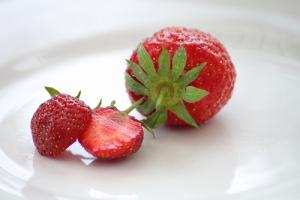This is my fifth and final post on plant knowledge from a series detailing different parts and areas of plants that you may or may not know, using all the notes I wrote and collected when I did my RHS L2 course.
Let me know what you think – interesting, boring or just indifferent I’d really like to know.
As an extra challenge I’m going to see if I can get each post under 500 words. Don’t count me though


Courtesy of Manchester Monkey
Part Five – Fruit and Germination
When we think about fruit the first thing that tends to come into our minds are the types we eat like apples and plums. However fruit is a word that describes not only parts of a plant but what it does as well as how it grows.
What is a fruit?
Once the fertilized ovary of a flower becomes ripe it is called a fruit. The ovary itself contains either a single seed or many within it. Fruit and seeds result from fertilization. Most flower parts die apart from the pericarp (The fruit wall; derived from the ovary wall) section.
The pericarp has three layers:
- Exocarp = soft outside skin (like a berry) or nut
- Mesocarp = middle, fleshy part which is usually edible, like an orange
- Endocarp = central part surrounding the seeds – can be soft (like a berry) or hard like ‘drupe’ (A single hard-coated seed or ‘stone’ that is surrounded by a fleshy outer covering.).
The seed cannot germinate until the protective layers have broken down. Fruits can be divided into 2 different sections: Dry & fleshy. Dry means that the pericarp is dry. Within dry and fleshy this can be broken down again into two parts as to which way the fruit splits open:
- Dehiscent = split open - the effect of drying out the ‘carp’ and has some parts which are stronger than others. As it dries it splits open along the lines of weakness. Nuts are
- Indehiscent = fruit remains closed around the seed until it rots - don’t split open. Instead they decay or are eaten by an animal from which the seeds then reappear! (Such as tomato seeds!)
Some parts other than the fruit becomes fleshy;
Fruit that isn’t fruit
A false fruit = this is formed in a place other than the ovary wall such as the receptacle on top of the flower stalk.
The fleshy part is made therefore from the receptacle. Other things to remember about fruit:
- When the pericarp becomes fleshy it turns into water and sugar. It would dry out otherwise.
- Often a pericarp has a waxy blume or downy hairs, like a peach to help reduce evaporation.
- The outside of the fruit is often very colourful to encourage seed dispersal by animals.
- The seed is protected by a hard layer called the testa (the seed coat), which resists digestion. A berry has a hard testa. In a drupe it is the part of the endocarp such as olives and cherries.
The ovary protects the ovuale before fertilization and afterwards – the seeds are then protected. Fruit is structured from the ovary. Its wall is a pericarp containing one seed or many.
Fruits can be dispersed by animals and are protected in three ways depending on the fruit:
- false fruit – the seed is protected by the pericarp e.g. strawberry
- drupes – the seed is protected by the endocarp e.g. cherry
- berries – the seed is protected by the testa e.g. tomato
Dispersal must never be confused with pollination! The two are completely separate. Pollination is a way of reproducing where as dispersal is merely the movement of seed from one place to another.
That’s it then – all done….
If you’d like to know about any other parts of plants, or indeed would like a series on something else around the garden be sure to let me know below, or get in touch – I’m always up for a challenge!
_______________________________________________________________________
Cover photo courtesy of Brian Hoffman
